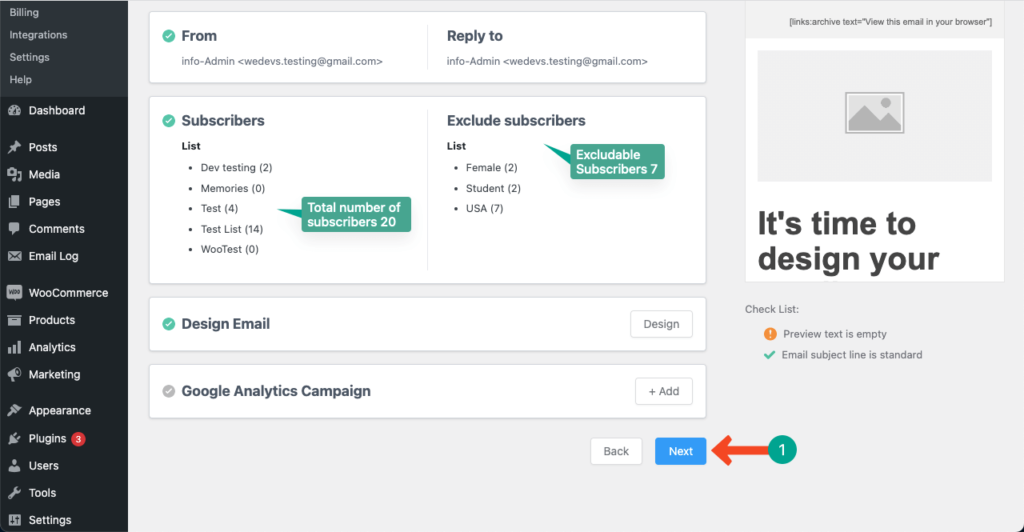What is a Suppression List in Email Marketing and Best Practices

It’s intriguing when you start thinking like a newsletter subscriber while you are the one who is sending weekly newsletters to your subscribers.
People in your email lists are so crucial whether you send them emails or not. Here comes the need for an email suppression list.
An email suppression list is a tool used in email marketing to manage and maintain the list of recipients who should not receive certain email communications.
This blog will show you what is a suppression list in email marketing, and how to utilize this list at best. Keep reading.
What is a Suppression List in Email Marketing

An email suppression list, also known as a “do-not-email” list, is a database or list of email addresses that an organization or sender has identified as ineligible or opted out of receiving email communications.
These email addresses belong to individuals who have explicitly requested to be removed from the sender’s email distribution lists or have otherwise indicated that they do not wish to receive further emails from the sender.
The strategy is a critical component of responsible and compliant email marketing.
It helps your business respect the preferences of your email recipient, maintain legal boundaries, and manage their email campaigns effectively while maintaining the quality and integrity of the email lists.
Why Do You Need Email Suppression Lists – Benefits
Well, let’s explain why you need to create/ generate suppression lists for email marketing. Also, you must use an email marketing platform that offers the feature –
Opt-Out Requests
Email addresses are typically added to the suppression list in response to opt-out requests. This can occur when recipients click on an “unsubscribe” link in an email campaign or explicitly request to stop receiving emails through other means, such as replying to an email with an unsubscribe request.
Legal Compliance
Maintaining an email suppression list is essential for compliance with email marketing regulations and laws, such as the CAN-SPAM Act in the United States and the General Data Protection Regulation (GDPR) in Europe. These regulations require organizations to honor opt-out requests promptly and provide an easy way for recipients to unsubscribe.
Preventing Unwanted Emails
The primary purpose of an email suppression list is to prevent sending emails to individuals who have expressed a desire not to receive them. This helps avoid irritating recipients, reduces the likelihood of spam complaints, and maintains a sender’s reputation.
Email Segmentation
Email marketers often use suppression lists as a segmentation tool. By excluding specific email addresses from certain email campaigns, they can tailor their messages to different recipient groups more effectively. For example, a company might suppress customers who have already made a recent purchase to avoid sending them redundant promotional offers.
Data Integrity
Email suppression lists also contribute to data integrity by ensuring that the sender’s email list is up-to-date and accurate. Removing opted-out email addresses from the main distribution list prevents future email campaigns from including these addresses accidentally.
Third-Party Sources
When organizations obtain email lists from third-party sources, they should use their suppression list to filter out addresses that have opted out or unsubscribed from their communications. This helps maintain the quality and compliance of the acquired lists.
Sometimes, organizations may temporarily suppress email addresses for specific reasons, such as during system maintenance or a period of excessive email sending. This prevents email recipients from receiving emails during those specific times.
Types of Email Suppression List

There are many types of email suppression lists, and you can create different lists based on your user activities. Let’s find out some of the most important ones –
1. Hard Bounces
Email addresses that are hard-bounced in previous campaigns can be called the most solid email suppressions. You must gather all of these hard-bounced email addresses and create a suppression list. It happens because those emails become unavailable.
2. Spam Compliance
You may have found some people who marked your email addresses as spam or reported for spam compliance. These email addresses should also be added to the suppression list until you resolve the issue.
Also Read: WordPress email going to spam and how to fix it
3. Unsubscribes
It’s a best practice for email marketing to add an unsubscribe link to each of your emails. And, it’s inevitable, just like some people subscribe to your list, a portion of them also unsubscribe. So, in your current email list, you will find people who lost interest in your list, and yet, you need some time to remove them and make your list up-to-date.
In such a situation, creating a suppression list with these unsubscribed email lists is helpful. Before permanently removing them, you can suppress these addresses from your ongoing email campaigns.
4. Preference-Based Suppression
Some recipients may express specific preferences about the type or frequency of emails they want to receive. Suppression lists can be used to ensure that these preferences are respected.
5. Legal and Regulatory Suppression
In compliance with laws like GDPR and CAN-SPAM, organizations may maintain suppression lists to exclude individuals or regions where email communication is restricted or prohibited.
6. Customized Suppression
Based on your specific business needs and marketing strategy, you may implement custom suppression rules. For example, you might suppress certain email addresses based on purchase history, demographics, or other criteria.
The specific types and criteria for email suppression may vary based on your organization’s policies, industry regulations, and email marketing platform capabilities.
Effective email suppression is essential for maintaining a positive sender reputation, compliance with laws, and respecting the preferences of your subscribers.
How to Exclude Email Suppression Lists While Sending an Email Campaign
weMail is a WordPress email marketing platform that comes with superb email automation features. It has a powerful template library and editor, and cost-effective sending gateways to make your email sending affordable.
The good news is that weMail has introduced a feature named ‘Exclude Recipient’ to exclude email suppression lists while sending a campaign.
With the help of this feature, you can exclude an individual subscriber from a specific email campaign. Also, it’s possible to exclude an email suppression list, segment, or tags.

To learn the detailed process, read the detailed guide on the weMail exclude recipient feature.
Email Suppression List Best Practices
Email suppression lists are essential for maintaining a healthy email marketing program, ensuring compliance with regulations, and respecting your subscribers’ preferences.
Here are some best practices for managing email suppression lists –
Honor Unsubscribe Requests Promptly: Always respect unsubscribe requests immediately. When someone opts out, remove their email address from your active email list promptly to prevent further communications.
Regularly Update Lists: Regularly update your suppression lists to ensure accuracy. Remove invalid email addresses, expired suppressions, and addresses of individuals who have re-subscribed or re-engaged with your emails.
Implement a Double Opt-In Process: Use a double opt-in process when subscribers sign up for your emails. This helps ensure that only individuals who actively confirm their subscription receive your emails, reducing the chances of adding incorrect or unwanted addresses to your list.
Segment Your Suppression Lists: Segment your suppression lists based on the reasons for suppression (for example – unsubscribed, bounced, complained). This makes it easier to manage and troubleshoot issues if they arise.
Automate Suppression List Management: Use email marketing software that can automate the management of suppression lists. You can do it easily with weMail
Implement Inactivity Suppression: Regularly review and suppress email addresses of subscribers who haven’t engaged with your emails for an extended period. This can help improve your sender’s reputation and save resources.
Regularly Audit and Monitor Suppression Lists: Conduct periodic audits of your suppression lists to check for accuracy and consistency. Monitor your email marketing campaigns for any signs of suppression list issues, such as sending to unsubscribed addresses.
Also, there’s an additional best practice is to train your email marketing team about the necessity of a suppression list in email marketing, and how to utilize it.
Up to You
The best thing about keeping and managing a suppression list in email marketing is simple. It helps you to learn who is not interested, and it will guide you to create more subtle and nuanced email lists. The whole process only leads you to more email conversions.
Having a lot of heavy email list never ensures success. In email marketing, it’s always about keeping the real people in the loop and nurturing them.



